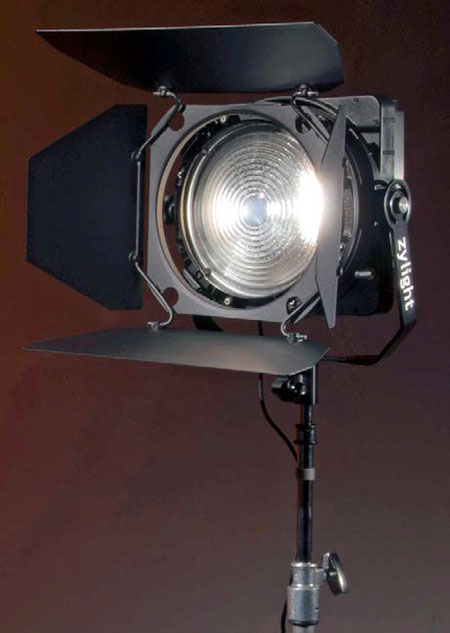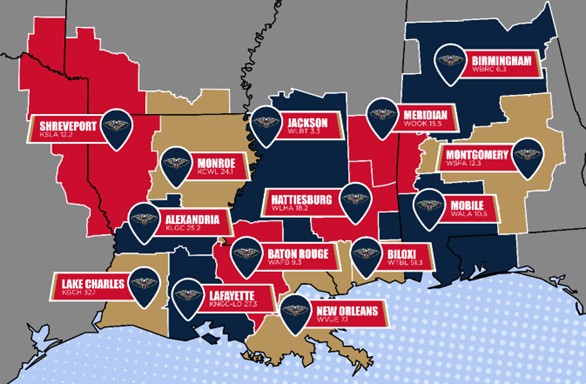Studios Call for Specialized Lights
SEATTLE—Developers of LED lighting fixtures promised a lot to early adopters of solid-state lighting: low power draw, low heat generation, requiring less air conditioning, long bulb life and more. However, while the fast return on investment thrilled the station or studio’s business manager, there were issues with LED lighting including spikes in their color rendering.
A lot has changed since those early days, and while there are still arguments about whether color rendering is equal or better than incandescent halogen light, the fact is that there are some very impressive LED lighting fixtures out there.

Cineo Lighting’s HS digital soft source provides lighting for the set of “Jimmy Kimmel Live!”MAXIMUM AMOUNT OF CONTROL
In developing its Skypanel, ARRI’s marching orders were simple enough, noted John Gresch, the company’s vice president of lighting products. They wanted an LED-based soft light that would “provide the smoothest possible light with the maximum amount of control of the color... and number two, what can we do to give maximum creativity to Skypanels’ users.”
The Skypanel lighting tool provides great flexibility to the lighting designer on one-off projects, but Gresch also pointed toan opposite case. “There are those ‘set-and-forget’ lighting jobs,” such as a studio that’s going to be hosting newscasts around the clock. “It’s lit by the designer, and they just want to make sure every time they turn it on they get the exact same look,” he said. So a key factor is repeatability.
The slow dimming of LED lighting fixtures in the studio or performance stage can have a dramatic effect. But most LED fixtures have a rough time maintaining a slow dim below five percent to zero, instead jumping abruptly to dark. BB&S Lighting addressed this challenge by developing its Area 48 Studio soft light, which continues smooth dimming all the way through five percent down to zero.
“We developed new electronics around a 48V system, and we not only solved the dimming problem but also came up with a light that will remain flicker-free up to 20,000 frames a second,” said Peter Plesner, owner and founder of BB&S in Venice, Calif. With convection cooling instead of a fan, the remote phosphor Area 48 fixture operates silently.

Photon Beard’s Highlight LED installation in London’s YouTube studio.PHOSPHOR-COATED
When Cineo first got into the LED lighting business, “we basically started the company with a line of studio lighting, the HS Series, and that’s really been our flagship product,” said CEO Rich Pierceall.
The professional video industry's #1 source for news, trends and product and tech information. Sign up below.
The El Granada, Calif.,- based company was an early pioneer of remote phosphor technology for solid-state lighting where, rather than doping a phosphor coating on the actual LED bulbs, the phosphor coating is applied to a translucent surface, which is placed inches away from the LEDs.
The phosphor-coated panels are available in a range of color temperatures, from 2700K to 6500K. “We’re seeing a trend right now in studios for lighting at 4300K, especially in television studios and news studios,” said Pierseall. “There are technical reasons for that, because there is a fuller spectrum at 43 than there is at 32 in LED lighting.”
K5600, as its name would suggest, has long delivered daylight color-balanced lighting equipment based around metal halide discharge (HMI) lamps. But with Sylvania’s release of 3200K HMI bulbs, “somebody with one of our Joker kits can augment existing tungsten fixtures in a studio grid, with the large range of Joker accessories,” said Ryan Smith, president of K5600 in N. Hollywood, Calif.
The Sylvania gas discharge bulbs have not been given a nickname by their manufacturer, but are currently available in 200W, 400W and 800W. “We are patiently awaiting the 1600 tungsten bulb, which will essentially make a Joker 1600 produce as much light as a 5K incandescent, and be able to run off house power.”
A studio that’s getting rented out for this production and that is likely to see a wide variety of cameras being used. That can present a challenge for lighting designers. “Digital cameras are not the same,” said Scott Stueckle, sales manager for Kino Flo in Burbank, Calif. “They have different spectral sensitivity curves by which they process white light.”
The company’s Select and Diva lighting fixtures can add or subtract green or magenta to match different cameras’ color characteristics. “We’ve pulled in all the information on those cameras,” Stueckle said. A light output setting that is optimized to a particular camera’s sensitivity curve can be programmed into the fixture’s pre-sets.
MIXED LIGHTING
The classic modeled lighting for a news anchor in the studio, key, fill and backlight, requires a variety of lights. “We pride ourselves on having a mixed lighting solution,” said Alan Ipakchian, Vitec Videocom global marketing manager/brand manager for Litepanels.
Litepanels was early on the LED scene with its 1-foot by 1-foot arrays of light emitting diodes, an inherently soft light source. A few years ago the company introduced its next-generation 1x1s, the Astra, with larger LEDs, more power and better color. DMX modules for the Astra are an accessory.
For key and backlights, the company developed daylight and tungsten LED Fresnels, available in four-, six-, nine- and 12- inch lens sizes. Litepanels’ Fresnel fixtures have built-in DMX control.
U.K.-based Photon Beard has been making fluorescent soft light fixtures for 20 years. As the company’s vice president of U.S. operations Pete Challinger explained, “Fluorescent light fixtures all had one thing in common, and that is that they had a reflector system that focused the light and generally moved all the light in the direction you wanted it to point.”

Zylight’s F8-200 LED Fresnel can be controlled by an iPhone or iPad with the company’s Zylink Bridge. When people developed LED soft lights, he continued, “it’s like they’d forgotten everything they learned.” The result from most companies was a rectangle of light up in the grid, and that light went everywhere. Photon Beard, in its Highlight LED fixtures, uses remote phosphor cylindrical tubes with a reflector system to achieve the same efficiencies they realized in their fluorescent fixtures, with the advantages of LED technology.
Zylight offers its F8-200 Fresnel fixtures as a quick and convenient way to light a studio. “It’s equivalent to a 575W HMI, but produces almost no heat,” said Joe Arnao, president of the Los Angeles-based company. The fixtures provide an 8-inch diameter glass Fresnel lens that can adjust the beam angle from 16 to 70 degrees, and collapse down to less than 5 inches thick for packing away.
In the studio the F8s can be powered off AC and controlled directly on the fixture or via DMX. Wireless operation can be achieved by powering the lights off of battery packs, and Zylight’s own wireless control. “You add our new Zylink Bridge and free app, and you can control Zylights using your iPhone or iPad,” said Arnao.
